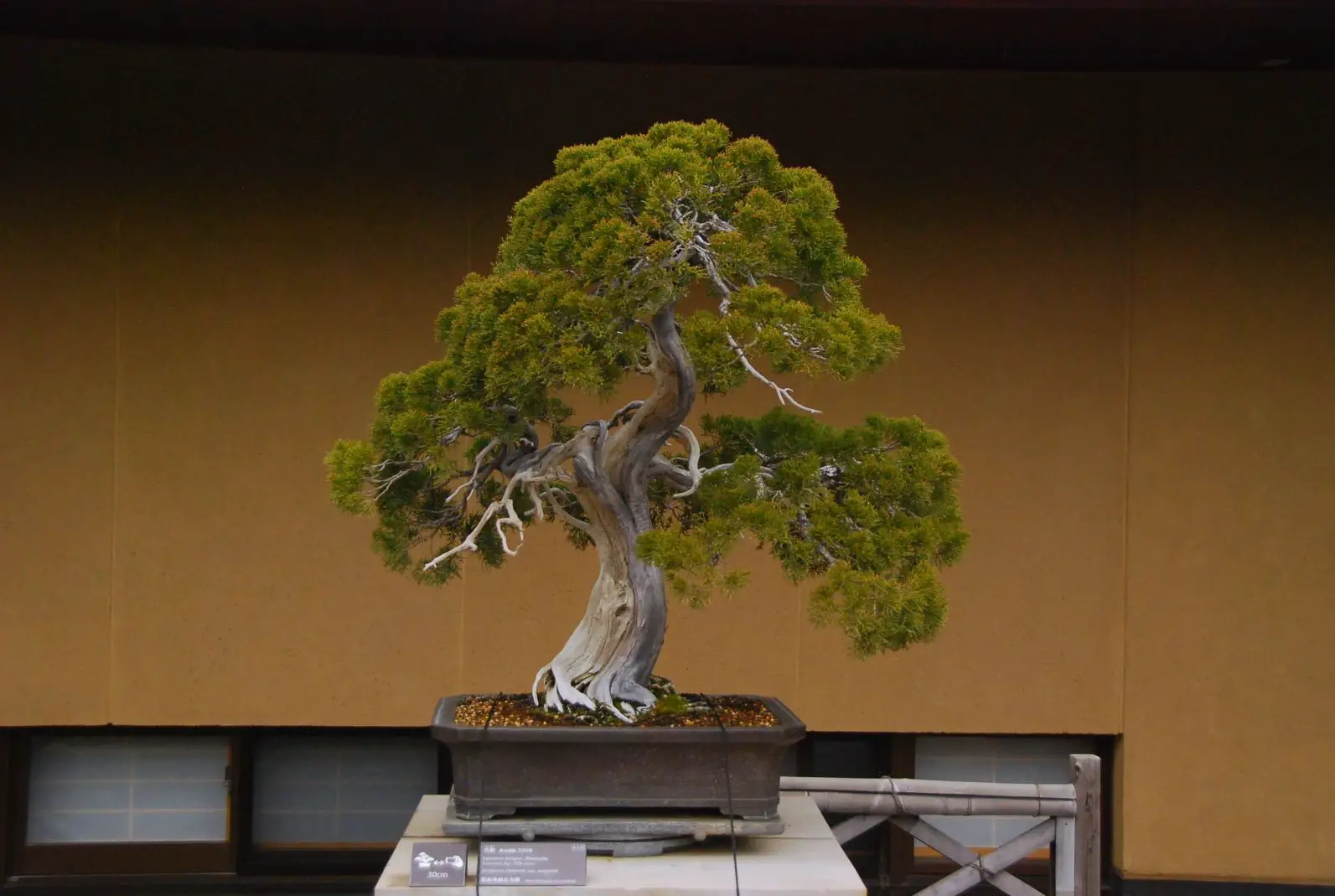Juniper Bonsai Water Needs
How Much Water Does a Juniper Bonsai Need?
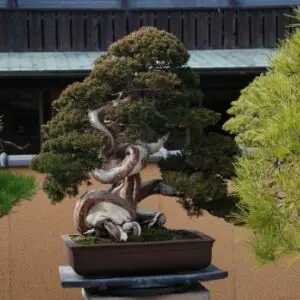
Generally speaking, juniper bonsai can tolerate drought quite well but they need lots of water and moisture to maintain their vigorous growth and beautiful foliage mass. But this does not mean they like wet environments. They in fact prefer to be kept in well-drained, drier soil rather than very wet one.
The amount of water a juniper bonsai needs can vary depending on several factors;
- Type of soil,
- Amount of soil (the size of pot),
- Climate/weather,
- Season,
- Placement of the tree,
- Size and age of the tree, and
- Species/cultivar of juniper.
To know more about the factors affecting bonsai water needs, please check the following article.
When watering your juniper bonsai, it is important to give it a thorough watering so that the water reaches all parts of the soil and drains out. This can be done by pouring water evenly over the soil until water starts to drain out of the bottom of the pot. This ensures that the roots are fully hydrated and helps prevent dry spots in the soil.
It is also important to give water from above the tree so that the foliage also gets water. Watering juniper leaves helps (1) cool and prevent losing water, (2) absorb water, and (3) wash away dust/dirt.
If you are interested in the benefits of watering/misting bonsai leaves, the following post might be helpful.
How to Know If Juniper Bonsai Needs Water
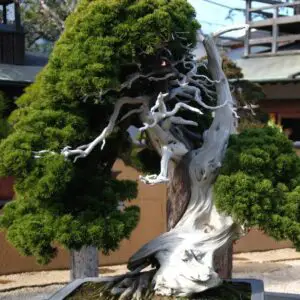
100 million yen Shimpaku juniper
While the frequency of watering can vary depending on several factors as I mentioned earlier, there are some signs to look out for that indicate that your juniper bonsai may need water.
Feel the soil
The first and most obvious sign that your juniper bonsai needs water is if the soil feels dry when you touch it.
You can check the moisture level of the soil by sticking your finger about an inch into the soil. If it feels moist yet the soil does not stick to your finger, it is time to water your bonsai. It goes without saying that when it feels dry, you should water it immediately.
Weighing by hand
Another way to check the moisture level is to measure its weight by lifting the pot.
For this, you should have prior knowledge of how much it weighs usually. Every time you look after your juniper bonsai trees, you lift the bonsai pot. You would know, after doing it over and over, how much it weighs and when it feels lighter.
I think this is a good way to know bonsai water needs especially when the pot is full of roots and you cannot stick your finger into the potting soil.
Touch the moss
If your juniper bonsai has moss over the soil, you can check your juniper bonsai water needs by touching the moss. If the moss feels completely dry, it is probably time to water. I said probably because feeling moss can be deceiving. The moss can feel dry but the soil underneath may not as moss acts as mulching.
It is important to pay attention to your juniper bonsai and check the moisture level regularly. Conifer needles do not wilt easily as the deciduous leaves and the signs of dehydration may be difficult to catch especially when you are a beginner.
Overwatering and Underwatering Juniper Bonsai
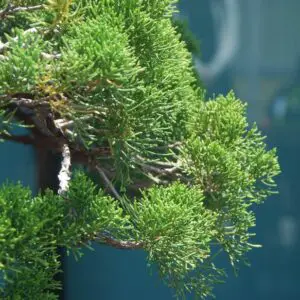
Shimpaku juniper needles
You can overwater and underwater your juniper bonsai, both of which can harm your juniper bonsai. Giving too much water can lead to root rot, a condition where roots are damaged due to excessive moisture, while too little water can cause the tree to dry out and die.
Here are some signs that your juniper bonsai may be experiencing overwatering and underwatering.
Signs of overwatering and underwatering
- Stunted growth or lack of growth
- Gradual fading of leaf color
- Wilting
- Branch dieback
Both overwatering and underwatering share common symptoms because they damage the root system in one way or the other.
Note that these symptoms can be seen with nutrient deficiencies, fertilizer burn, root bound, wrong placement of the tree, and pests/diseases and it may be difficult to determine what causes your tree to wither instantly. You may have to explore possible causes and come up to a conclusion.
Factors causing overwatering and underwatering
Overwatering of your juniper bonsai can be caused by various factors including:
- giving water too frequently,
- not allowing the soil to dry out between watering,
- very high humidity,
- using a very shallow and wide pot (which causes difficulty with drainage), or
- using a soil mix that retains too much moisture (e.g. high % of organic matter).
Underwatering of your juniper bonsai can be caused by various factors including:
- not watering frequently enough,
- not providing enough water at each watering,
- using a very small pot (doesn’t hold enough soil),
- the surface of the soil covered by moss (which sometimes repels water),
- rootbound (cannot absorb water), or
- low humidity or high temperatures.
To prevent overwatering or underwatering, it is important to understand the specific watering needs of your juniper bonsai, monitor the soil moisture level and pay attention to the signs of wrong water management.
How to Water Juniper Bonsai
How often to water
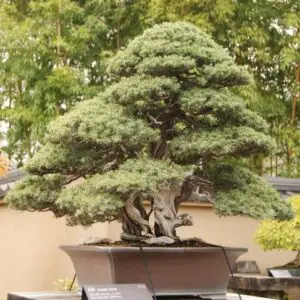
Needle juniper
Though they are drought tolerant, juniper bonsai loves water. The general rule for watering a juniper bonsai is;
- 1-2 times a day in spring and fall,
- 2-3 times a day in summer, and,
- Once every 2 to 3 days in winter.
The frequency of watering your juniper bonsai tree should be adjusted on several factors as follows:
-
- Frequency of rain in the region (humidity),
- Temperature,
- Amount of sunlight,
- Age of the tree (the younger, the more water), and
- When it is last repotted (the longer, the more water retention due to the development of the roots).
As always, it is important to pay attention to your juniper bonsai and check the moisture level regularly.
Best time of the day to water
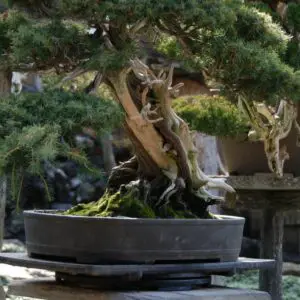
Needle juniper
The timing of watering your juniper bonsai can also affect its health and growth. While it is important to keep the soil moist (not wet), it is best to avoid watering your juniper bonsai during the hottest part of the day if you can.
The best time to water your juniper bonsai is in the morning before the sun has fully risen. This allows the water to penetrate the soil and be absorbed by the roots before the heat of the day sets in.
The next watering should be done in the early evening. This allows the tree to absorb water that has been evaporated during high sun.
As mentioned, it is best to avoid watering your juniper bonsai during the high sun, say between 11 am and 2 pm. The water is likely to get hot inside the pot during these hours, leaving the root system boiled and may be damaged.
But if you notice your juniper bonsai is completely dried out, it is better to give water as soon as possible no matter what time of the day it is. It will be difficult to revive your bonsai tree if it is gone out of water for a long time.
Best way to water
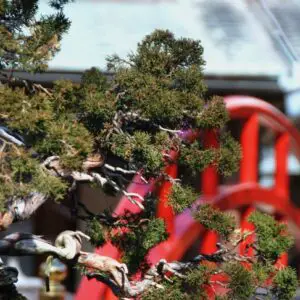
Shimpaku juniper
When you water your juniper bonsai, there are two methods you should apply: (1) watering the soil and (2) watering the foliage.
Watering the soil
Water the soil around the base of the tree using a watering can or other suitable watering tools. This is common to watering all bonsai trees but make sure that the water reaches the roots. Avoid pouring water too quickly onto the soil as this can cause it to run off from the surface and not penetrate deeply enough.
Watering the foliage
It is also important to give water from above the tree so that the foliage also gets water. Watering juniper leaves helps (1) cool and prevent losing water, (2) absorb water, and (3) wash away dust/dirt.
Watering the leaves cleans small debris on the leaves and washes away insects (their eggs) and fungi. Watering from above is even more important if your juniper bonsai has deadwood features. Deadwood will crack when it is too dry. So, it is necessary to keep it sufficiently moist with watering.
If you grow Shimpaku juniper, watering the foliage is especially important because they grow in misty, high mountains naturally.
To know more about Shimpaku juniper, the following article might be helpful.
Watering from below
You should avoid watering from below unless your juniper bonsai is completely dry and needs immediate and full watering. Sitting your bonsai in a tray filled with water often leads to overwatering because the excess water does not drain and the soil is kept wet all the time.
Misting instead of watering directly
Misting is a popular technique used by many bonsai growers to increase the humidity around the foliage. It is beneficial for juniper bonsai to mist as well especially when it is hot and dry but you cannot mist your tree in place of watering it directly.
Misting should be supplemental, not a substitute for watering because it does not supply enough water to the roots. Juniper bonsai, like all plants, requires a consistent and adequate supply of water for the root system to thrive.
How much to water
When you water your juniper bonsai, give it in abundance so that the water reaches all parts of the soil. Make sure to check if the water drains out from the bottom.
It is important to give enough water at a time and let the soil dry to an adequate level. Giving a bit of water between short intervals keeps their root system always wet, which may lead to root rot.

